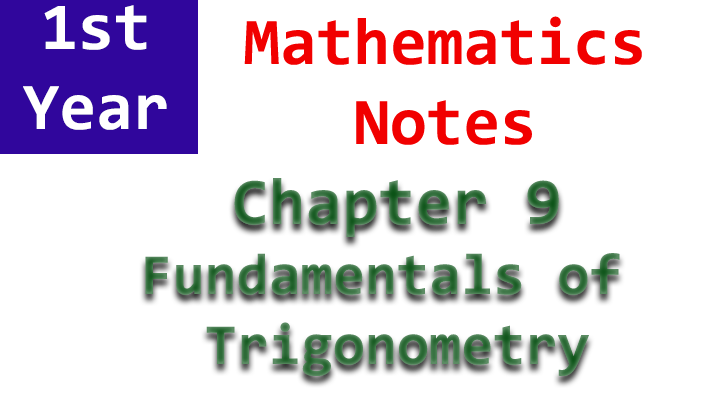In the intricate world of mathematics, few branches captivate the imagination and find as widespread utility as trigonometry. As we embark on our journey into Chapter 9 of the F.Sc 1st Year Math curriculum, we delve deep into the fundamentals of trigonometry. Trigonometry, often referred to as the science of triangles, is a pivotal field that bridges geometry and algebra, enabling us to comprehend and manipulate the relationships between angles and sides of triangles.
This chapter is a gateway to a realm of mathematical principles and techniques that not only form the bedrock of various scientific disciplines but also hold real-world applications in fields as diverse as engineering, physics, architecture, and navigation. Join us as we unravel the mysteries of trigonometry, unlocking its inherent beauty and significance in the world of mathematics.
Trigonometry, a vital field within Mathematics, derives its name from three Greek words: “Trei” (meaning three), “Goni” (meaning angles), and “Metron” (meaning measurement), literally translating to “measurement of triangles.” A solid understanding of trigonometry is indispensable for delving into calculus. Its applications span various disciplines including Business, Engineering, Surveying, Navigation, Astronomy, as well as the Physical and Social Sciences.
Units of Angle Measurement
Concept of an Angle: An angle is formed when two rays emanate from a common point. The ray from which the angle begins is termed the “initial side,” while the other is the “terminal side.” The angle’s identity depends on the direction of rotation from the initial side to the terminal side. An angle is considered positive when the rotation is counterclockwise and negative when it is clockwise. Angles are typically denoted by Greek letters like α (alpha), β (beta), γ (gamma), θ (theta), etc. In Figure 9.1, ∠AOB is positive, and ∠COD is negative.
Two commonly used angle measurements are Degrees and Radians, explained as follows:
Sexagesimal System (Degree, Minute, and Second): When the initial ray OA rotates counterclockwise until it aligns with itself, it forms a 360-degree (360°) angle. Notably, 1/2 rotation (180°) constitutes a straight angle, while 1/4 rotation (90°) is a right angle. This system divides 1 degree (1°) into 60 minutes (60′) and 1 minute (1′) into 60 seconds (60″). As this measurement system originated in English and 90 and 60 are multiples of 6 and 10, it is known as the English or Sexagesimal system. Therefore, 1 rotation (counterclockwise) equals 360°, and one degree (1°) comprises 60 minutes (60′), with one minute (1′) further dividing into 60 seconds (60″).
Conversion between D°M′S″ and Decimal Form:
(i) To convert degrees with minutes and seconds to decimal form, you add the degrees, minutes divided by 60, and seconds divided by 3600.
(ii) To convert a decimal degree to degrees with minutes and seconds, you separate the whole degrees, multiply the fractional part by 60 to get minutes, and then multiply the remaining fractional part by 60 to get seconds.
Example 1: Convert 18° 6′ 21″ to decimal form.
Solution:
First, convert minutes and seconds to degrees: 6′ = 6/60° = 0.1° and 21″ = 21/3600° ≈ 0.005833°.
Add these values to 18°: 18° + 0.1° + 0.005833° ≈ 18.105833°.
Example 2: Convert 21.256° to the D°M′S″ form.
Solution:
Separate the whole degrees (21°) from the decimal part (0.256°).
Convert the decimal part to minutes: 0.256° × 60′ = 15.36′.
Convert the fractional part of minutes to seconds: 0.36′ × 60″ = 21.6″.
Express the result: 21° 15′ 22″ (rounded to the nearest second).
Circular System (Radians): Another angular measurement system, the Circular System, is particularly useful in advanced mathematics, especially in Calculus. In this system, angles are measured in radians.
Definition: A radian is the measure of the angle formed at the center of a circle by an arc whose length equals the circle’s radius. If you consider a circle with a radius of “r,” an angle ∠AOB at the center of the circle, which subtends an arc of length “r,” is defined as 1 radian.

